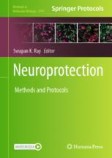Search
Search Results
-
Sufficient Cav-1 levels in the endothelium are critical for the maintenance of the neurovascular unit in the retina
BackgroundCaveolin-1 (Cav-1) is a pivotal protein in the plasma membrane. Studies on homozygous Cav-1 deficient mice revealed that Cav-1 is essential...

-
Characterization of the blood–brain barrier in genetically diverse laboratory mouse strains
BackgroundGenetic variation in a population has an influence on the manifestation of monogenic as well as multifactorial disorders, with the...

-
Pericytes as mediators of infiltration of macrophages in multiple sclerosis
BackgroundMultiple sclerosis (MS) is a neurodegenerative condition of the central nervous system (CNS). It is associated with blood–brain barrier...

-
Amyloid Beta–Mediated Neurovascular Toxicity in Alzheimer’s Disease
The brain vascular system receives one-fifth of the total oxygen from the cardiac output, and this transport system is highly dependent on...
-
ROS impairs tumor vasculature normalization through an endocytosis effect of caveolae on extracellular SPARC
BackgroundThe accumulation of reactive oxygen species (ROS) in tumor microenvironment (TME) is an important player for tumorigenesis and progression....

-
The Provenance, Providence, and Position of Endothelial Cells in Injured Spinal Cord Vascular Pathology
Endothelial cells (ECs) and pericytes are present in all blood vessels. Their position confers an important role in controlling oxygen and nutrient...

-
Vascular Endothelial Growth Factor Augments the Tolerance Towards Cerebral Stroke by Enhancing Neurovascular Repair Mechanism
The breakdown of the blood–brain barrier (BBB) is a critical event in the development of secondary brain injury after stroke. Among the cellular...

-
Platelet-derived growth factor signaling in pericytes promotes hypothalamic inflammation and obesity
BackgroundPericytes are a vital component of the blood–brain barrier, and their involvement in acute inflammation was recently suggested. However, it...

-
Asiaticoside Attenuates Blood–Spinal Cord Barrier Disruption by Inhibiting Endoplasmic Reticulum Stress in Pericytes After Spinal Cord Injury
The blood–spinal cord barrier (BSCB) plays a vital role in the recovery of spinal cord function after spinal cord injury (SCI). Pericytes,...

-
Pericyte loss leads to circulatory failure and pleiotrophin depletion causing neuron loss
Pericytes are positioned between brain capillary endothelial cells, astrocytes and neurons. They degenerate in multiple neurological disorders....

-
Combination human umbilical cord perivascular and endothelial colony forming cell therapy for ischemic cardiac injury
Cell-based therapeutics are promising interventions to repair ischemic cardiac tissue. However, no single cell type has yet been found to be both...

-
Loss with ageing but preservation of frontal cortical capillary pericytes in post-stroke dementia, vascular dementia and Alzheimer’s disease
Cerebral pericytes are an integral component of the neurovascular unit, which governs the blood–brain barrier. There is paucity of knowledge on...

-
Activation of Sigma-1 Receptor Enhanced Pericyte Survival via the Interplay Between Apoptosis and Autophagy: Implications for Blood–Brain Barrier Integrity in Stroke
Stroke is a cerebrovascular disorder that affects many people worldwide. Pericytes play an important role in stroke progression and recovery. The...

-
The Active Role of Pericytes During Neuroinflammation in the Adult Brain
AbstractMicrovessels in the central nervous system (CNS) have one of the highest populations of pericytes, indicating their crucial role in...

-
The amyloid-β degradation intermediate Aβ34 is pericyte-associated and reduced in brain capillaries of patients with Alzheimer’s disease
An impairment of amyloid β-peptide (Aβ) clearance is suggested to play a key role in the pathogenesis of sporadic Alzheimer’s disease (AD). Amyloid...

-
Pericytes Regulate Cerebral Perfusion through VEGFR1 in Ischemic Stroke
Neurons in the penumbra (the area surrounding ischemic tissue that consists of still viable tissue but with reduced blood flow and oxygen transport)...

-
Glutaric Acid Affects Pericyte Contractility and Migration: Possible Implications for GA-I Pathogenesis
Glutaric acidemia I (GA-I) is an inherited neurometabolic childhood disease characterized by bilateral striatal neurodegeneration upon brain...

-
Blood–brain barrier leakage and perivascular collagen accumulation precede microvessel rarefaction and memory impairment in a chronic hypertension animal model
Hypertension (HT) is one of the main causes of vascular dementia, lead to cognitive decline. Here, we investigated the relationship between cerebral...

-
Human early-onset dementia caused by DAP12 deficiency reveals a unique signature of dysregulated microglia
The TREM2–DAP12 receptor complex sustains microglia functions. Heterozygous hypofunctional TREM2 variants impair microglia, accelerating late-onset...

-
Chronic effects of blast injury on the microvasculature in a transgenic mouse model of Alzheimer’s disease related Aβ amyloidosis
BackgroundAltered cerebrovascular function and accumulation of amyloid-β (Aβ) after traumatic brain injury (TBI) can contribute to chronic...

